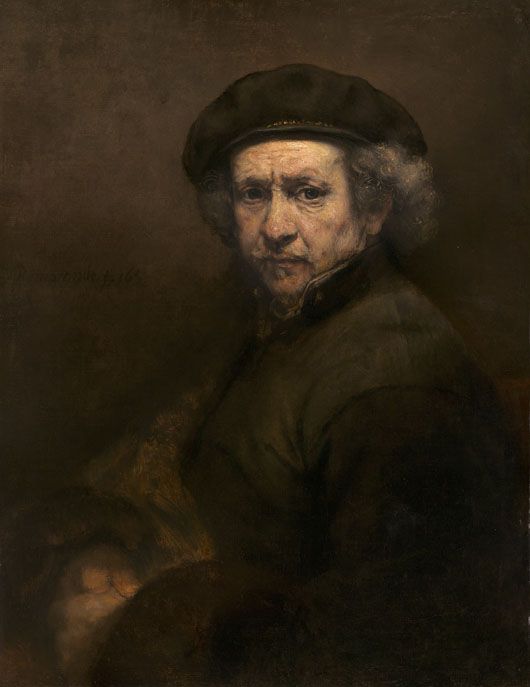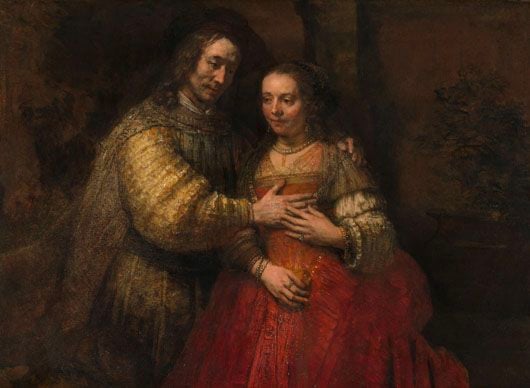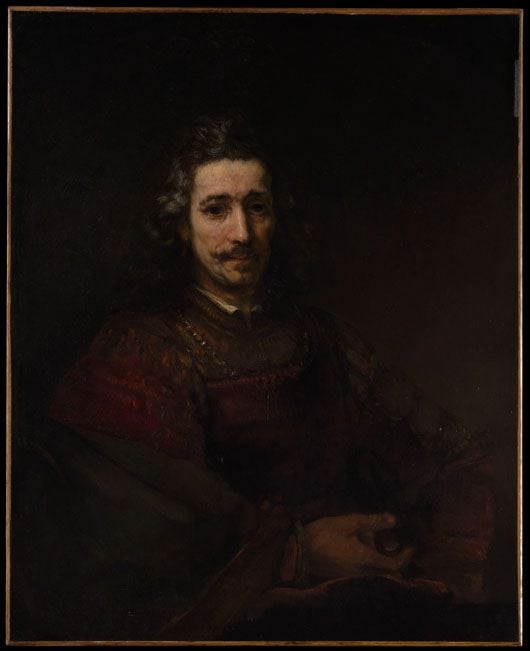The first known use of the word was in 1784, from the Italian impasto, the noun of the verb impastare, “to put in paste.” The impasto technique is a method used in painting where paint is applied to an area of the surface in very thick layers, usually thick enough that the brush or painting-knife strokes are visible. When dry, impasto provides texture and adds a three-dimensional quality to the artwork. This technique has the ability to make an image appear as though it is coming out of the painting.
The Impasto Technique of Rembrandt

Impasto is paint laid on a canvas or panel in quantities that make it stand out from the surface and is usually thick enough that brush or palette knife strokes are visible. The first known use of the word was in 1784, from the Italian impasto, the noun of the verb impastare, “to put in paste.” (Harper, 2013)
The heavy viscosity and slow drying time of oil paint make it a suitable medium for the impasto painting technique. Watercolor and tempera paint are not satisfactory for this technique because they lack these properties and do not form continuous films surrounding pigment particles.
Thick passages of paint can serve several functions in paintings. First, the relief of impastos can intensify highlights by increasing the light-reflecting properties of the paint. This effect extends the tonal range of the painting by making highlights appear more brilliant. Second, skillfully and minutely worked impastos can depict wrinkled skin or the texture of intricately crafted surfaces of jewelry and fabrics, such as in the works of Rembrandt, Frans Hals, and Diego Velázquez. The nineteenth-century painter Vincent van Gogh used impastos to build up and define the forms in his paintings with thick daubs of paint so that the viewer could see the strength and speed by which the artist applied the paint, giving them added expressiveness. Fourth, impastos can emphasize the physical qualities of the paint itself, as seen in the works of such twentieth-century painters as Jackson Pollock and Willem de Kooning.
The combination of chiaroscuro and impasto in Rembrandt’s paintings shows an affinity with the method of Titian, who was the first to use thickly applied and dragged impasto. This marked the innovation of replacing the painterly means of direct representation with a method of suggestion and illusion. (Liedtke, 1995)
Rembrandt used impastos to accentuate highlights by the increased illumination of surfaces facing the light source and the exaggeration of shadows on surfaces facing away from the light source. It appears that this was the sole intention of the impasto in the illuminated parts of the face in the Self Portrait of 1659 at the National Gallery in Washington. The brushstrokes are scarcely related to the form of the face. (De Wetering, 1997)
It is unclear exactly how Rembrandt created the textures encountered in the lights of his portraits, most notably the skin textures of male subjects. It may be reproduced by building up thick layers of opaque paint and then dragging a soft brush over the surface while it is still wet. In most cases, after executing highlights in thick layers, Rembrandt would eventually wholly or partially cover these with thin paint as glazes.
As Rembrandt developed this glazing technique over impastos, he employed a fast drying white consisting of lead white, chalk, leaded crystal glass, and smalt. The increasingly heavier impastos in paintings of his later period, modified by thin glazes of color, created illusory special effects, an extreme example of which is the man’s golden sleeve in The Jewish Bride in the Rijksmuseum in Amsterdam.

Impastos can be obtained by using a high proportion of pigment combined with unmodified oil, which, over some time, results in dry, hard paint. The relatively stiff paint needed for impastos can also be obtained using a heat-bodied thickened with metal salts, such as lead, which gives a soft appearance and a relatively yielding paint. Analysis suggests that Rembrandt used heat-bodied and unmodified oils with a larger proportion of pigments in his impastos. (White, 1994)
Heat polymerization has several effects on the oil. Drying properties are improved and further enhanced by adding metal salts during the heat-bodying process. The refractive index of the oil is increased, thereby increasing the saturation of the pigment color. The high molecular weight of polymerized oils increases the oil’s flow out and leveling, giving the paint film a glossier appearance. The pigment is less liable to sink in the oil film, which changes less in volume than an unmodified oil film, reducing the amount of wrinkling that may occur. White paints are less susceptible to yellowing because, as the polyunsaturated fatty acids initially present in the paint film are destroyed by the formation of carbon-carbon single bonds, there is less possibility for the formation of colored organic compounds, the presence of which gives the yellow appearance to the film.
The character of impastos achieved by freshly applied paint consisting of a larger proportion of pigment to oil, especially with such pigments as lead white and lead-tin yellow, is different from that provided by heat-bodied oil. The highly varying and often commented appearance of Rembrandt’s brushwork in his thickly-applied passages could have been obtained by the juxtaposition of paint consisting of heat-bodied oil and unmodified oil containing a high proportion of pigment.
Much of the thickest impastos in Rembrandt’s paintings are formed of lead white, sometimes with lead-tin yellow. Where lead white is used in thick passages, it does not produce excessive cracking as the paint film dries and ages because, prevalent with all lead-containing pigments, lead white enhances the drying of oil paint, forming a particularly tough and flexible film. (Bomford, 2006)
Rembrandt used chalk as a pigment in its own right and an extender in impastos, where bulk without the density is required in the paint. When mixed in oil, chalk is virtually transparent, making it suitable as a modifying agent for glazing paints that also contain translucent colored pigments. The effect of adding chalk to oil paint is to add body and translucency to glazes without inducing a significant color change.

The complexity and variety of techniques in Rembrandt’s paintings set him apart from his contemporaries. The thickly-applied paint often consists of distinct hues and values forming broken-color passages. Separately applied colors remain clean and distinct and can be seen from an average viewing distance, as in the painting of the Man with a Magnifying Glass. This attention to detail in brushstrokes recalls Roger de Pile’s remark that Titan and Rembrandt knew that some colors should not be overmixed but should be touched as little as possible with the brush. De Piles praised Rembrandt for his flesh colors which are “not less true, less fresh, nor less exquisite than Titian’s,” and remarked that his way of using color is unique. (de Piles, 1715)
References
(Harper, 2013) Douglas Harper, Online Etymology Dictionary, retrieved June 7, 2013. http://www.etymonline.com/index.php?term=impasto
(Liedtke, 1995) Walter Liedtke, Carolyn Logan, Nadine M. Orenstein, Stephanie S. Dickey, “Rubens and Rembrandt: A Comparison of Their Techniques,” Rembrandt/not Rembrandt in the Metropolitan Museum of Art, New York: Metropolitan Museum of Art, 1995, p. 78, 79.
(De Wetering, 1997) Ernst Van De Wetering, Rembrandt: The Painter at Work, Amsterdam University Press, 1997, p. 220.
(White, 1994) Raymond White and Jo Kirby, “Rembrandt and his Circle: Seventeenth-Century Dutch Paint Media Re-examined,” National Gallery Technical Bulletin Volume 15, 1994.
(Bomford, 2006) David Bomford, Art in the Making: Rembrandt, Yale University Press, 2006, p. 36
(de Piles, 1715) Roger de Piles, Abregé de la vie des peintres, 2nd ed., Paris, 1715.
Frequently Asked Questions
What is the impasto technique in oil painting?
Which artists are known for using the impasto technique?
The impasto technique has been used by numerous artists throughout history. One of the most famous artists to use this method is Vincent van Gogh; his work is renowned for its heavy, swirling strokes of thick paint. Other artists known for their use of impasto include Rembrandt, Diego Velázquez, and more recently, Willem de Kooning and Lucian Freud. These artists have applied the technique across a range of styles and movements, showcasing its versatility.
How does the impasto technique affect the appearance of a painting?
By building up thick layers of paint, the impasto technique creates a textured, sculptural aspect of the artwork, adding depth and dimensionality. This can intensify the perception of light and shadow in the painting due to the way light reflects off the peaks and falls into the troughs of the paint. It can also create a tactile quality, inviting the viewer to not just look at the painting but also to experience it in a more tangible, physical way.
What types of paint are best for the impasto technique?
Oil paint is typically the preferred medium for the impasto technique due to its thick consistency and slow drying time. This allows artists to create texture and dimension that remain intact once the paint dries. Acrylic paints can also be used for impasto, but they tend to flatten as they dry. To create an impasto effect with acrylics, one might need to use an acrylic gel medium to increase the thickness of the paint.
Are there any special tools or brushes needed for the impasto technique?
While any brush can be used to create an impasto effect, certain tools can make the process easier. Palette knives are particularly well-suited for impasto, as they can apply paint in large, thick quantities and can also create unique textural effects. Brushes with stiff bristles, such as hog or synthetic brushes, can also effectively apply thick paint. Lastly, a tool known as a painting knife, which is similar to a palette knife but has a pointed tip, can be used to create finer lines and details with the impasto technique.
How does the drying process work in the impasto technique?
Due to the thickness of the paint, artworks created with the impasto technique require a longer drying time. Oil paint already has a relatively slow drying time, and when applied thickly for impasto, it can take weeks, months, or even years to fully dry. It's important to note that the drying process is not simply evaporation but rather an oxidation process. This means the paint hardens as it reacts with oxygen in the air. One must handle impasto paintings with extra care to avoid any damage during this extensive drying period.
How can an artist achieve a specific color intensity with the impasto technique?
Color intensity in the impasto technique can be achieved through a method called 'optical mixing'. When two colors are placed side by side in thick strokes, the eye will perceive a blend of these colors from a distance, creating an intense color effect. This can give a painting more vibrancy than if the colors were physically mixed. Van Gogh, for instance, often used this technique in his impasto work to create an intense and energetic color palette.
Are there any specific challenges or limitations with using the impasto technique?
One of the primary challenges with the impasto technique is the risk of cracking. When thick paint is applied, the surface can dry faster than the layers underneath, leading to cracks or even the paint peeling off. Artists can mitigate this by ensuring each layer of paint is properly dry before adding another and using mediums that increase the flexibility of the paint.
Another challenge is the weight of the artwork. The buildup of heavy layers of paint can significantly increase the weight of a painting, so artists must ensure that the canvas or panel used is sturdy enough to support the extra weight.
Finally, due to the longer drying times associated with impasto, artists must be prepared to work slowly and patiently. The technique requires a careful, deliberate approach that can be quite different from other painting methods.










